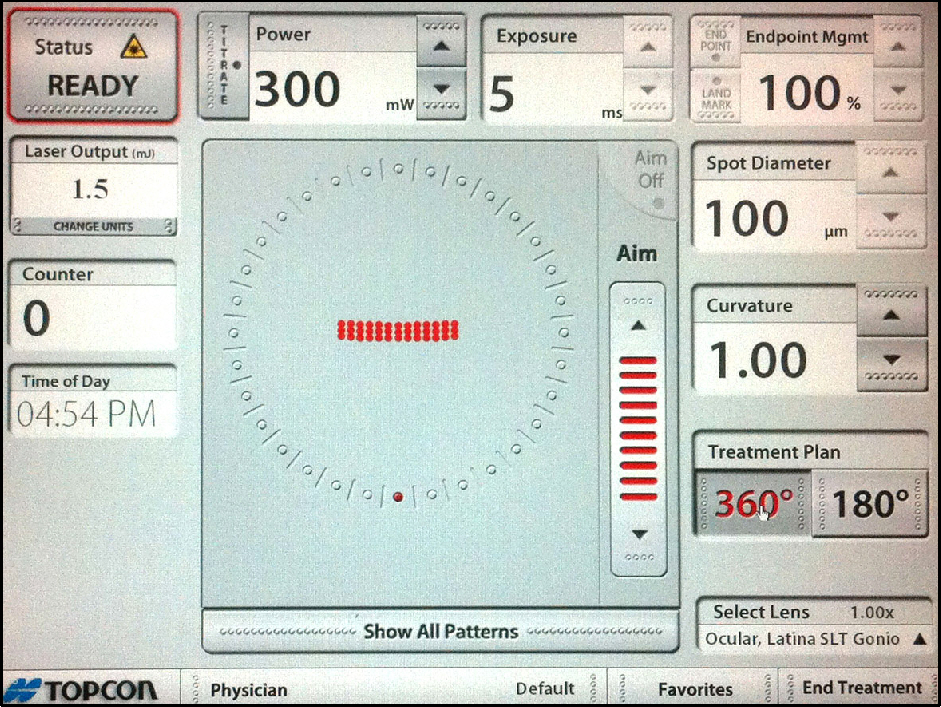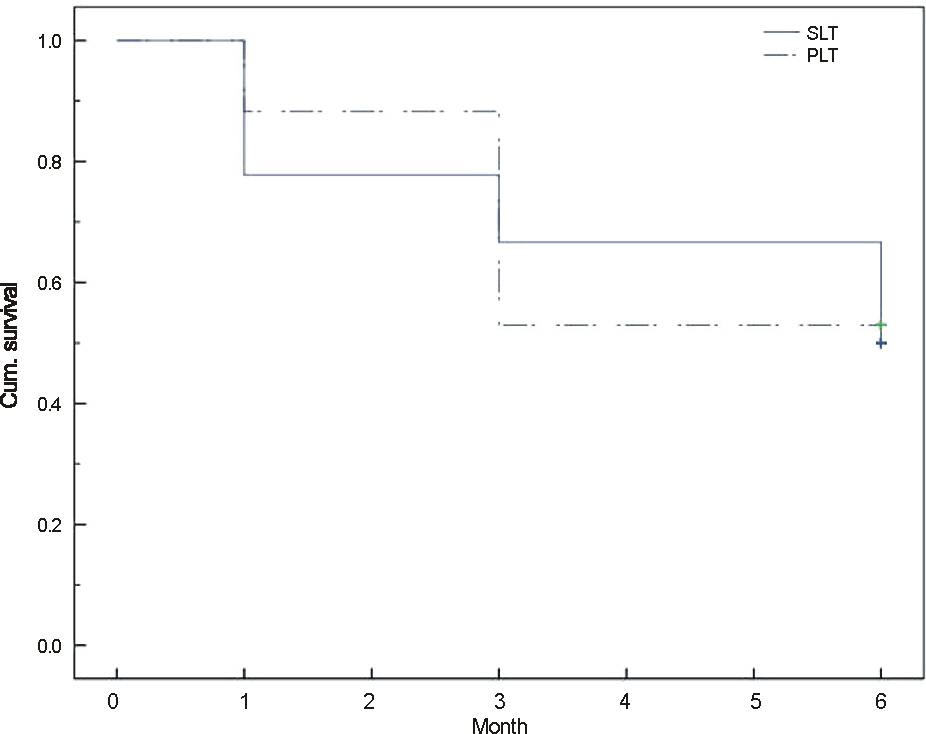J Korean Ophthalmol Soc.
2014 Apr;55(4):563-569.
Short-Term Clinical Outcomes of Laser Trabeculoplasty Using a 577-nm Wavelength Laser
- Affiliations
-
- 1Department of Ophthalmology, Dankook University Medical College, Cheonan, Korea. changmh@dankook.ac.kr
Abstract
- PURPOSE
To evaluate the pressure-lowering effects of single-spot laser trabeculoplasty and patterned laser trabeculoplasty using a 577-nm wavelength laser.
METHODS
A total 35 eyes of 35 patients with primary open-angle glaucoma were enrolled in this study. Eighteen eyes of 18 patients were treated with 360degrees single-spot laser trabeculoplasty and 17 eyes of 17 patients were treated with 360degrees patterned laser trabeculoplasty. All patients were evaluated after laser trabeculoplasty at 1 week, 1 month, 3 months, and 6 months using slit lamp examination and Goldmann applanation tonometry.
RESULTS
At 6 months postoperatively, the single-spot laser trabeculoplasty group had a mean IOP of 15.89 +/- 3.89 mm Hg with a mean IOP reduction of 37.1%, while the patterned laser trabeculoplasty group had a mean IOP of 17.57 +/- 2.64 mm Hg with a mean IOP reduction of 27.1%.
CONCLUSIONS
Laser trabeculoplasty with a 577-nm optically pumped semiconductor laser was safe and demonstrated an IOP lowering effect. There were no significant differences in the IOP lowering effects between the single-spot laser trabeculoplasty and the patterned laser trabeculoplasty.
Figure
Reference
-
References
1. Wise JB, Witter SL. Argon laser therapy for open-angle glaucoma. A pilot study. Arch Ophthalmol. 1979; 97:319–22.2. Latina MA, Park C. Selective targeting of trabecular meshwork cells: in vitro studies of pulsed and CW laser interactions. Exp Eye Res. 1995; 60:359–71.
Article3. Cho BJ, Kim TW, Woo SJ, et al. Short-term clinical outcome of patterned scanning laser photocoagulation with short exposure time in diabetic retinopathy. J Korean Ophthalmol Soc. 2009; 50:376–82.
Article4. Turati M, Gil-Carrasco F, Morales A, et al. Patterned laser trabeculoplasty. Ophthalmic Surg Lasers Imaging. 2010; 41:538–45.
Article5. Hodapp E, Parrish RK II, Anderson DR. Clinical decisions in glaucoma. St. Louis: Mosby;1993. p. 52–61.6. Wise JB. Glaucoma treatment by trabecular tightening with the argon laser. Int Ophthalmol Clin. 1981; 21:69–78.
Article7. Van Buskirk EM, Pond V, Rosenquist RC, Acott TS. Argon laser trabeculoplasty. Studies of mechanism of action. Ophthalmology. 1984; 91:1005–10.8. Alvarado JA, Alvarado RG, Yeh RF, et al. A new insight into the cellular regulation of aqueous outflow: how trabecular meshwork endothelial cells drive a mechanism that regulates the permeability of Schlemm's canal endothelial cells. Br J Ophthalmol. 2005; 89:1500–5.
Article9. Bradley JM, Anderssohn AM, Colvis CM, et al. Mediation of laser trabeculoplasty-induced matrix metalloproteinase expression by IL-1beta and TNFalpha. Invest Ophthalmol Vis Sci. 2000; 41:422–30.10. Samples JR, Singh K, Lin SC, et al. Laser trabeculoplasty for open-angle glaucoma: a report by the american academy of ophthalmology. Ophthalmology. 2011; 118:2296–302.11. Worthen DM, Wickham MG. Laser trabeculotomy in monkeys. Invest Ophthalmol. 1973; 12:707–11.12. Park JJ, LEE JW, Lee KW. Comparison of clinical outcomes of argon laser versus selective laser trabeculoplasty in POAG. J Korean Ophthalmol Soc. 2008; 49:1491–500.
Article13. Brancato R, Carassa R, Trabucchi G. Diode laser compared with argon laser for trabeculoplasty. Am J Ophthalmol. 1991; 112:50–5.
Article14. Chung PY, Schuman JS, Netland PA, et al. Five-year results of a randomized, prospective, clinical trial of diode vs argon laser trabeculoplasty for open-angle glaucoma. Am J Ophthalmol. 1998; 126:185–90.
Article15. Kramer TR, Noecker RJ. Comparison of the morphologic changes after selective laser trabeculoplasty and argon laser trabeculoplasty in human eye bank eyes. Ophthalmology. 2001; 108:773–9.
Article16. Allingham RR. Shields textbook of glaucoma. 6th ed.Wolters Kluwer: Lippincott Williams&Wlikins;2011. p. 455.17. Jang YS, Kim JM, Lim TH, et al. Comparison of 180° and 360° selective laser trabeculoplasty. J Korean Ophthalmol Soc. 2012; 53:291–6.
Article18. Schuele G, Rumohr M, Huettmann G, Brinkmann R. RPE damage thresholds and mechanisms for laser exposure in the micro-second-to-milisecond time regimen. Invest Ophthalmol Vis Sci. 2005; 46:714–9.19. Sramek CK, Leung LS, Paulus YM, Palanker DV. Therapeutic window of retinal photocoagulation with green (532-nm) and yellow (577-nm) lasers. Ophthalmic Surg Lasers Imaging. 2012; 43:341–7.
Article
- Full Text Links
- Actions
-
Cited
- CITED
-
- Close
- Share
- Similar articles
-
- Clinical Applications of a Non-ablative Fractional Dual Laser (1550/1927 nm)
- Development of Minimally Invasive Mid-infrared Lipolysis Laser System for Effective Fat Reduction
- Comparison of Short-term Outcomes of Argon Laser versus Selective Laser Trabeculoplasty in Open-Angle Glaucoma
- Comparison of Clinical Outcomes of Argon Laser Versus Selective Laser Trabeculoplasty in POAG
- Comparison of the picosecond and Q-switched Nd:YAG lasers in the treatment of pigmentary disorders: a retrospective case series in the Republic of Korea





